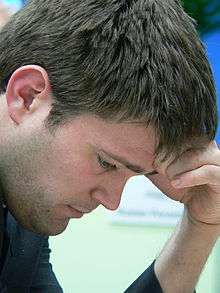Peter Heine Nielsen
| Peter Heine Nielsen | |
|---|---|
 Peter Nielsen at the 2005 Corus chess tournament | |
| Full name | Peter Heine Nielsen |
| Country | Denmark |
| Born |
May 24, 1973 Holstebro, Denmark |
| Title | Grandmaster |
| FIDE rating |
2645 (December 2016) (No. 53 in the January 2012 FIDE World Rankings) |
| Peak rating | 2700 (July 2010) |
Peter Heine Nielsen (born May 24, 1973) is a Danish chess player, and the current coach of chess world champion Magnus Carlsen.
Coaching career
Nielsen coached World Champion Vishy Anand from 2002 until 2012. Anand won the World Championship title in Mexico 2007, and defended it in Bonn 2008, Sofia 2010 and Moscow 2012.
Nielsen has been coaching world number one, Magnus Carlsen, since 2013. In 2013 Carlsen won the Candidates tournament giving him the right to challenge Vishy Anand for his title, which he later did and won.
Nielsen coached Carlsen in Khanty-Mansiysk 2005, when Carlsen as the youngest ever qualified for the candidate matches.
Chess career
Nielsen became an International Grandmaster in 1994. He won the Danish Chess Championship five times: in 1996, 1999, 2001, 2003, and 2008. He played for Denmark in seven Chess Olympiads, three times on top board, with an overall result of 60.1% (+24 −10 =35). He won an individual gold medal on third board at Moscow 1994.[1]
By September 2005, Nielsen's Elo rating in the FIDE list was 2668, at the time the highest rating for any player from the Nordic countries. He was formerly a second for World Champion Viswanathan Anand; he currently is a second for Magnus Carlsen.[2]
Other chess-related
On January 30, 2004 he played against Chessbrain[3] – which earned the world record as the largest distributed chess computer.
His handle on the Internet Chess Club is "Heine".[4]
Sample game
Peter Nielsen vs Henrik Danielsen, Danish Championship (playoff) 1996:
1. c4 f5 2. Nc3 Nf6 3. d4 e6 4. Nf3 Bb4 5. Qb3 a5 6. g3 b6 7. Bg2 Bb7 8. 0-0 0-0 9. Rd1 Qc8 10. Qc2 Bxc3 11. Qxc3 d6 12. b3 Nbd7 13. Ne1 h6 14. Bb2 Bxg2 15. Nxg2 Qe8 16. Rac1 Qf7 17. Qc2 Ne4 18. Ba3 e5 19. dxe5 Nxe5 20. Bb2 Ng6 21. e3 Rae8 22. Qe2 Re7 23. Rd5 Kh7 24. Rcd1 Ng5 25. h4 Ne4 26. h5 Ne5 27. Nh4 c6 (see diagram)
| a | b | c | d | e | f | g | h | ||
| 8 |  | 8 | |||||||
| 7 | 7 | ||||||||
| 6 | 6 | ||||||||
| 5 | 5 | ||||||||
| 4 | 4 | ||||||||
| 3 | 3 | ||||||||
| 2 | 2 | ||||||||
| 1 | 1 | ||||||||
| a | b | c | d | e | f | g | h | ||
28. Rxd6 Ng4
- Even after the best move 28...Nxd6, White is much better after 29.Rxd6 Kg8 30.Bxe5 Rxe5 31.Ng6 Re6 32.Rxe6 Qxe6 33.Nxf8 Kxf8 34.Qd3. Black's move is weaker and he loses quickly.
29. Rg6 Rg8 30. Rf1 Ng5 31. Qd3 Nh3+ 32. Kg2 Nhxf2 33. Rxf2 Rd7 34. Qc3 Nxf2 35. Kxf2 Qe6 36. Rxe6 1–0
Notes
- ↑ "Men's Chess Olympiads: Peter Heine Nielsen". OlimpBase. Retrieved 10 June 2011.
- ↑ "Carlsen catches coach of World Champion". ChessBase. Retrieved 31 January 2013.
- ↑ Chessbrain
- ↑ "Heine". Internet Chess Club. Retrieved 3 March 2011.
External links
- Peter Heine Nielsen player profile and games at Chessgames.com